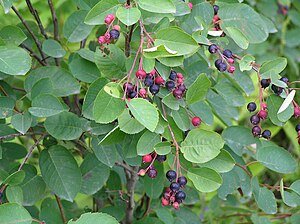Spiked rock pear
| Spiked rock pear | ||||||||||||
|---|---|---|---|---|---|---|---|---|---|---|---|---|

Spiked rock pear ( Amelanchier spicata ) |
||||||||||||
| Systematics | ||||||||||||
|
||||||||||||
| Scientific name | ||||||||||||
| Amelanchier spicata | ||||||||||||
| ( Lam. ) K. Koch |
The Amelanchier spicata ( Amelanchier spicata ), even Broom Felsenbirne called, is a plant species within the family of the rose family (Rosaceae). It is widespread in North America .
description
The spiked rock pear grows as a stiff, upright, broom-like shrub and reaches heights of 2 to 5 meters. Its numerous, thin trunks often grow short runners underground until they break through the ground separately from each other. Very old trunks can rarely be more than 7 meters high and more than arm-thick. The thick branches also grow upright. In very old specimens, the branches sometimes hang over due to their weight. The spiked Felksenbirne is brown to gray-black skinned . It forms egg-shaped, upwardly pointed buds . They are between 4 and 12 millimeters long, the width varies from 1 to four millimeters. They are usually dark wine-red in color, but can also be lighter in shade in the shade. The bud scales have long eyelashes on the inside, strong buds can also develop this hair on the outside.
The alternate leaves are arranged in a petiole and a leaf blade. The simple leaf blade is broadly elliptical to broadly obovate, broadest in the middle and the rounded blade tip ends in a 1 to 1.5 millimeter long spiked tip. The underside of the leaf is initially hairy yellowish tomentose underneath and later balded, only on the stem it is permanently hairy. The leaves are initially light green and in the autumn color unsightly yellow-brown spotty.
The flowering period extends from April to May. The stiffly upright, 3.5 to 6.5, rarely up to 7 centimeters long inflorescence usually contains eight to eleven (six to twenty) flowers. The fragrant or fishy-smelling, hermaphrodite flowers are radial symmetry and five-fold with a double flower envelope . The five white petals are 6 to 10 mm long, about twice as long as wide, obovate and ciliate on the edge. The ovary is densely hairy at the top.
The fruits are 8 to 10 mm thick and dirty red to blue-black when ripe. The fruits are sweet and have an unpleasant aftertaste.
The number of chromosomes is 2n = 68.
Occurrence
The wide natural range of the European rock pear extends from eastern Canada in New Brunswick , Newfoundland , Nova Scotia , Ontario , Prince Edward Island , Quebec to the eastern and central US states of Connecticut , Maine , Massachusetts , Michigan , New Hampshire , New Jersey , New York, Ohio , Pennsylvania , Rhode Island , Vermont , West Virginia , Illinois , Iowa , Minnesota , North Dakota , Wisconsin , Alabama , Delaware , Georgia , Maryland , North Carolina , South Carolina , and Virginia . There it populates light forests and bushes on loose, gravelly sandy soils , but it also goes on dunes and on rocky cliffs.
The European rock pear has been used as an ornamental shrub in parks and gardens since the beginning of the 19th century . Since then it has occasionally, mostly inconsistently, become wild, especially in the area of the coasts of the North and Baltic Seas. In Germany it is considered a naturalized neophyte .
literature
- Otto Schmeil, Jost Fitschen (greeting), Siegmund Seybold: The flora of Germany and the neighboring countries. A book for identifying all wild and frequently cultivated vascular plants. 95th completely revised u. exp. Edition. Quelle & Meyer, Wiebelsheim 2011, ISBN 978-3-494-01498-2 .
- Eckehart J. Jäger (ed.): Excursion flora from Germany. Vascular plants: baseline . Founded by Werner Rothmaler. 20th, revised and expanded edition. Spektrum Akademischer Verlag, Heidelberg 2011, ISBN 978-3-8274-1606-3 .
- Henning Haeupler , Thomas Muer: picture atlas of the fern and flowering plants of Germany (= the fern and flowering plants of Germany. Volume 2). 2nd, corrected and enlarged edition. Published by the Federal Agency for Nature Conservation. Ulmer, Stuttgart 2007, ISBN 978-3-8001-4990-2 .
- Dietmar Aichele, Heinz-Werner Schwegler: The flowering plants of Central Europe. Franckh-Kosmos-Verlag, 2nd revised edition 1994, 2000, Volume 2: Pine plants to butterfly plants. ISBN 3-440-08048-X .
Individual evidence
- ↑ a b c d e f g h Besen-Felsenbirne. In: FloraWeb.de.
- ↑ Fred-Günter Schroeder: Amelanchier. In: Hildemar Scholz (Hrsg.): Illustrated flora of Central Europe . Founded by Gustav Hegi. 2nd completely revised and expanded edition. Volume IV Part 2B: Spermatophyta: Angiospermae: Dicotyledones 2 (3) (Rosaceae, 2nd part) . Blackwell, Berlin / Vienna a. a. 1995, ISBN 3-8263-2533-8 , pp. 385-404 .; A. spicata : pp. 402-404 .
- ^ Erich Oberdorfer : Plant-sociological excursion flora for Germany and neighboring areas . 8th edition. Verlag Eugen Ulmer, Stuttgart 2001, ISBN 3-8001-3131-5 . Page 510.
- ↑ Amelanchier spicata in the Germplasm Resources Information Network (GRIN), USDA , ARS , National Genetic Resources Program. National Germplasm Resources Laboratory, Beltsville, Maryland.
Web links
- Amelanchier spicata at Plants For A Future . Retrieved November 8, 2014.
- Spiked rock pear. In: FloraWeb.de.
- Distribution map for Germany. In: Floraweb .
- Thomas Meyer: Data sheet with identification key and photos at Flora-de: Flora von Deutschland (old name of the website: Flowers in Swabia )
- Images: habitus , habitus , branches with leaves and flowers , unripe and ripe fruits
